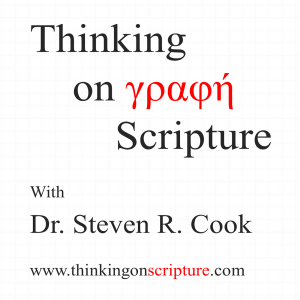
Saturday Aug 21, 2021
The Lord's Supper
The Lord’s Supper is mentioned in the Gospels of Matthew (26:26-29), Mark (14:22-25), Luke (22:19-20), and by the apostle Paul in his letter to the Christians at Corinth (1 Cor 11:23-34). The Lord’s Supper is also called the Eucharist, from the Greek word εὐχαριστέω eucharisteo, which means to give thanks, which is what Christ did when He instituted this church ordinance (Luke 22:19). And, it is called Communion, from the Geek word κοινωνία koinonia, which means communion, fellowship, or sharing (1 Cor 10:15-17), because it took place during a community meal where believers fellowshipped with each other during a time of Bible study and prayer (see Acts 2:42).
The Lord’s Supper was instituted by Jesus on the night He and the disciples were celebrating the Passover meal. This was the night before His crucifixion. The Passover meal celebrated God’s deliverance from the final plague on Egypt as the Lord passed over the homes of those who had sacrificed an unblemished lamb and placed its blood on the doorpost and lintel (Ex 12:1-51). The flawless lamb foreshadowed the sinless humanity of Jesus who is “a lamb unblemished and spotless” (1 Pet 1:19), “the Lamb of God who takes away the sin of the world” (John 1:29). Jesus is “our Passover lamb” (1 Cor 5:7), and His death paid the price for our sins (Mark 10:45; Eph 1:7; Heb 9:22).
Jesus’ death instituted the New Covenant which was given to Israel and will find its ultimate fulfillment in the future millennial kingdom. Because Christ inaugurated the New Covenant, some of the spiritual blessings associated with it are available to Christians today; specifically, forgiveness of sins (Jer 31:34; Matt 26:28; Heb 10:17) and the indwelling Holy Spirit (Ezek 36:26-27; 37:14; 1 Cor 3:16; 6:19).
The elements of the Lord’s Supper include unleavened bread and red juice. The unleavened bread symbolizes the sinless humanity of Jesus (2 Cor 5:21; Heb 4:15; 1 John 3:5). The red juice symbolizes the “blood of the covenant, which is poured out for many for forgiveness of sins” (Matt 26:28). Throughout the church age, there have been four major views concerning the elements of the Lord’s Supper: 1) The Roman Catholic view—Transubstantiation—teaches that the bread and red juice, without losing its form or taste, becomes the literal body and blood of Christ. 2) The Lutheran view—Consubstantiation—holds that Christ is present in and with the bread and red juice in a real sense. 3) The Reformed view—Spiritual—teaches that Christ is spiritually present in the bread and red juice. 4) The Evangelical view—Symbolic—sees the bread and red juice as symbols that point to the body and blood of Christ. The first three views see Christ actually present in the bread and juice, whereas the last view sees the elements as symbols that point to Christ. The last view is similar to how one understands the sacrificial lamb in the OT, which sacrifice did not actually contain Christ, but rather pointed to Him and His atoning work on the cross. Likewise, the Lord’s Supper does not actually contain Christ, but points the believer to His sacrificial life and substitutionary death.
When Christians partake of the unleavened bread and red juice, we are recognizing our relationship with God through the life and death of Christ. Just as we are nourished bodily by physical food, so we are nourished spiritually by the life and shed blood of Jesus who died in our place. Eating the bread and drinking the red juice is a picture of the believer receiving the benefits that have been provided by the life and death of Jesus. There is a vertical and horizontal aspect to the Lord’s Supper. The vertical aspect indicates one is in a right relationship with God through faith in Jesus, for the Lord’s Supper has meaning only to the one who has trusted Christ as Savior and received forgiveness of sins and the gift of eternal life (John 3:16; 10:28; Eph 1:7). The horizontal aspect of the Lord’s Supper indicates one is walking in love and living selflessly towards other Christians (1 Cor 10:15-17; 11:17-34), for it is a picture of the love and selflessness of Christ who gave His life for the benefit of others. It is a sin to partake of the Lord’s Supper while behaving selfishly toward other believers, and God will punish those who do so (1 Cor 11:27-30). Paul instructed the Christians at Corinth to partake of the Lord’s Supper retrospectively by looking back at the sacrificial life and death of Christ (1 Cor 11:23-25), prospectively by looking forward to Jesus’ return (1 Cor 11:26), and introspectively by examining their attitudes and actions (1 Cor 11:27-32). A proper understanding of the Lord’s Supper will lead to unselfish love towards others (1 Cor 11:33-34a).
Summary
The Lord’s Supper was instituted by Jesus while celebrating the Passover meal on the night before His crucifixion. The unleavened bread symbolizes the perfect humanity of Christ, and the red juice symbolizes the blood of the New Covenant that was shed on the cross. Christians who partake of the Lord’s Supper see themselves as the beneficiaries of the spiritual blessings of forgiveness and the indwelling Holy Spirit. Eating the bread and drinking the juice is a picture of receiving Christ and all He did for us through His life and death. The Lord’s Supper instructs us to look back to the selfless love of Christ, forward to His return, and inward to one’s values and actions.
No comments yet. Be the first to say something!